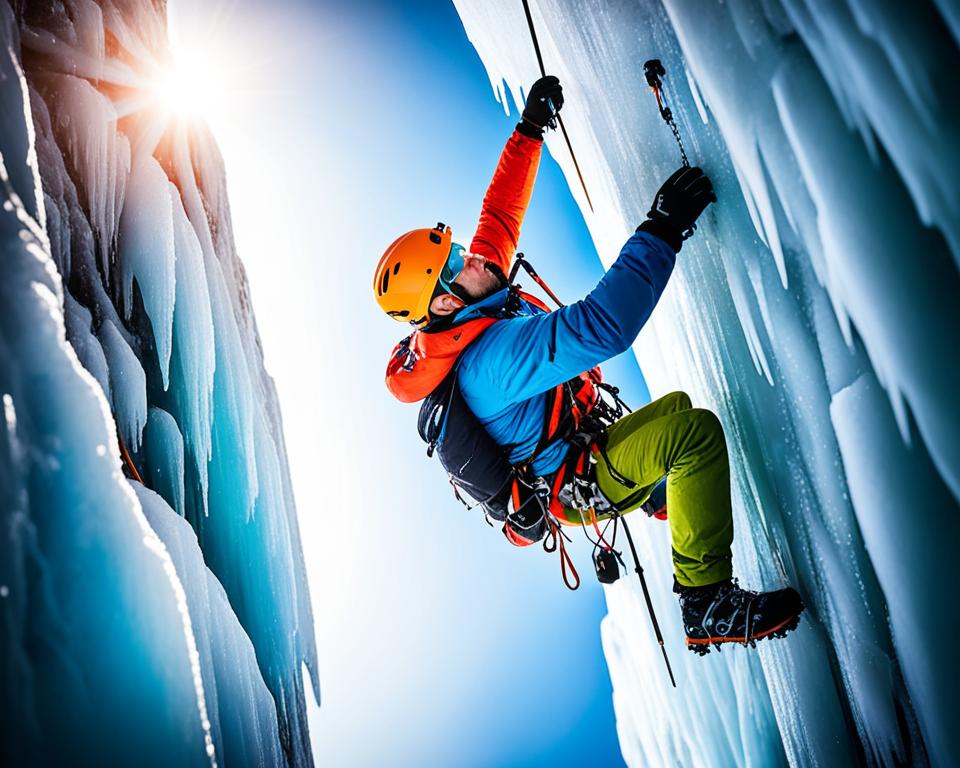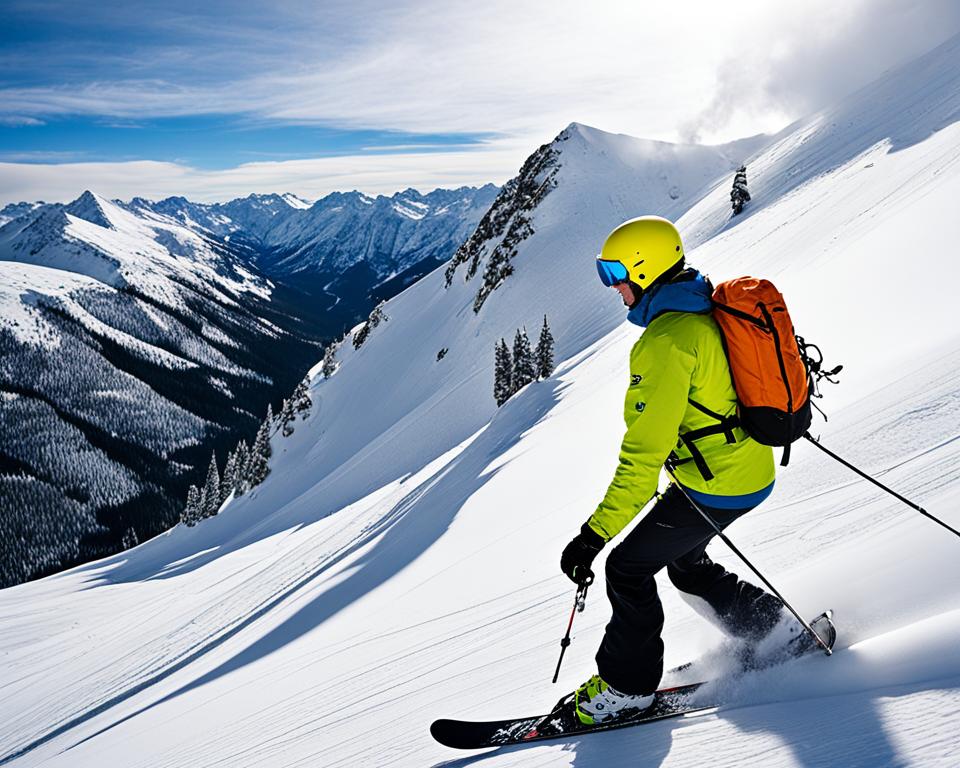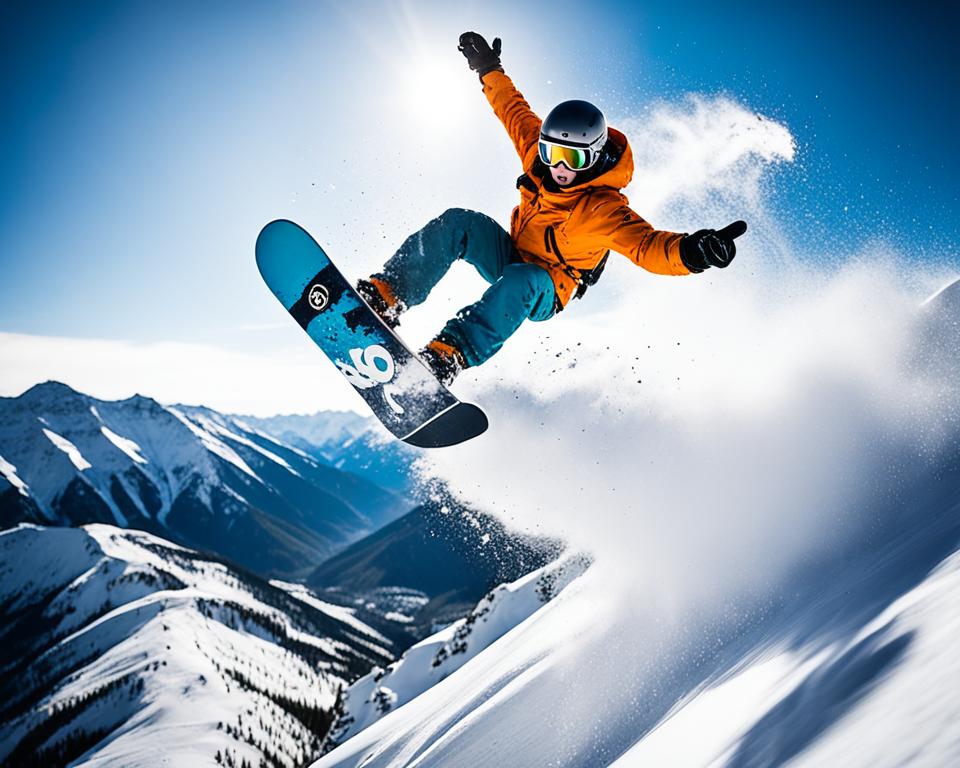Freeze Your Fear!: Extreme Snow and Ice Sports is a pulse-raising book. It explores ultra-snow sports’ world, introducing top athletes in these activities. This volume, measuring 7.5 x 0.5 x 9.25 inches and weighing 11 ounces, highlights the excitement of conquering nature. It dives into the thrill of participating in unique winter sports. Backcountry skiing, heli-skiing, and more extreme activities are featured.
Read interesting things at : kamilyle
Key Takeaways
- Discover the world of adrenaline-fueled extreme snow sports, from backcountry skiing to heli-skiing and snowboarding stunts.
- Learn about the elite athletes who excel in these thrilling winter pursuits and the thrill of conquering nature’s challenges.
- Explore a wide range of extreme snow sports, including ice climbing, ski mountaineering, and winter expeditions.
- Understand the importance of avalanche safety and how to navigate the risks in the backcountry.
- Immerse yourself in the captivating world of unique winter activities like ski biking and snow kayaking.
Introduction to Extreme Snow Sports
Extreme snow sports are a step beyond classic winter fun. They involve high risk and need serious skills. The goal is to beat nature and feel alive.
Defining Extreme Snow Sports
These sports take you outside usual ski tracks. You might find yourself climbing ice or skiing untouched snow. It’s all about enjoying winter in a new, exciting way.
The Thrill of Conquering Nature’s Challenges
Participating in extreme snow sports is a wild ride. Imagine skiing out in the open mountains or doing tricks on a snowboard. These sports let you tackle winter’s fury and come out on top. This challenge is what hooks many on these sports.
Backcountry Skiing
Backcountry skiing is thrilling and lets you explore untouched places. It’s about leaving the paths and finding your way through wild places. This type of skiing is perfect if you want to enjoy peace and unique landscapes far from the usual ski areas. In Colorado, you can do it all year. There are options from easy slopes with early snow to steep chutes later on.
Venturing Off the Beaten Path
The beauty of backcountry skiing is the freedom and thrill. You get to ski in areas where few do, finding fresh powder and amazing views. It’s exciting and rewarding, especially for those who love a challenge.
Essential Gear and Safety Precautions
It’s vital to have the right gear and know how to stay safe. Always carry avalanche gear and learn how to use it. Liberty Skis makes special gear for backcountry trips, which are light for climbing and strong for going downhill.
For your safety, going with a guide is a smart move. They know about avalanches and can help you if something goes wrong. With the right equipment and advice, you can have a safe and fun adventure.
Stunning Remote Locations
Backcountry skiing let’s you connect with nature in remote places. It offers breathtaking views in areas not many people see. In Colorado, you can visit these spots from November to April, finding untouched snow and the joy of being in the wild.
Heli-Skiing
Heli-skiing is not your average snow sport. It takes skiing far from the normal slopes using helicopters. This lets skiers reach untouched areas filled with perfect powder. It all began in the 1950s when Hans Gmoser, an Austrian, moved to Canada and founded heli-skiing. Soon after, the biggest heli-ski company, CMH (Canadian Mountain Holidays), was born in 1965. Imagine skiing on snow that no one has touched before, surrounded by nature’s beautiful, wild places like the Tordrillo Mountains in Alaska. Here, you get 1.2 million acres to ski on. Another top spot is the Chugach Range near Valdez, receiving 800 inches of snow every year. In Canada, there’s even more snow, with an average of 25 feet yearly.
This thrilling sport requires not just a love for skiing but also special gear and knowledge. Only the most experienced skiers should try it. Safety is key in heli-skiing. Teams carefully choose safe terrain and schedule trips when the weather is good. But, be ready to spend a lot. A day of heli-skiing in Canada can cost $1,300 or more. This makes heli-skiing one of the priciest ways to ski off the beaten path, but there are cheaper alternatives like cat-skiing.
Heli-skiing is not just a trend; it’s getting more popular. You can now do it in faraway places like the Himalayas, Alps, and even Antarctica. Yet, some countries, France, Austria, and Germany, have banned it. But this only makes it more intriguing for those seeking the ultimate adventure.
Snowboarding Stunts and Freestyle
Snowboarding stunts and freestyle have changed the sport. Riders do amazing tricks and jump high in the air. Since the 2010s, freestyle snowboarding has become very popular. It uses different features like rails, jumps, and halfpipes.
Mastering Tricks and Aerial Maneuvers
To land complex tricks, snowboarders need great balance and coordination. It’s important to start with basic tricks like presses, buttering, and ollies. By practicing a lot, snowboarders can do amazing stunts. They mesmerize crowds everywhere.
Halfpipe and Slopestyle Competitions
Events like halfpipe and slopestyle let snowboarders show their skills. Most ski areas in North America and Europe let people snowboard. Many have jumps and halfpipes. These competitions are exciting to watch, with lots of action and creativity from the riders.
Extreme Snow Sports
The world of extreme snow sports is full of thrills. Participants push the limits in winter’s harshest conditions. From backcountry skiing to ice climbing, these sports let you explore snow-covered landscapes in an exciting way.
The Adrenaline Rush of Extreme Winter Activities
People who love extreme snow sports are after a big rush. They do things like climb up icy waterfalls and ski down wild, untouched areas. Skills and special gear are a must. But when you conquer these tough challenges, the feeling is incredible.
Popular Destinations for Extreme Snow Sports
Places for extreme snow sports are often remote but beautiful. They have lots of snow and the right set-up for these daring activities. Think of ski resorts in the Arctic, backcountry lodges in the Rockies, or guided trips in the Himalayas. These spots are perfect for adrenaline junkies.
Doing extreme snow sports means diving into winter’s wonders. There’s nothing like skiing through fresh powder, climbing icy walls, or riding the wind. It’s all for those who want to feel the ultimate thrill and discover their boundaries. Are you ready for the adventure of a lifetime?
Ice Climbing
Ice climbing is a thrilling snow sport. It’s about climbing icy waterfalls, cliffs, and glaciers. You need special gear like ice axes and crampons. You also need advanced climbing skills. This sport’s lure is conquering icy heights in beautiful, untouched places.
Scaling Frozen Waterfalls and Glaciers
Ice climbing is more than traditional climbing. It needs special techniques for icy terrains. Climate change is shrinking glaciers and icy waterfalls. Climbers are racing to scale these diminishing natural wonders.
Technical Skills and Equipment
It takes strong arms and physical fitness to ice climb. Climbers spend a lot on gear for safety and performance. They often compete in difficulty and speed challenges. This sharpens their climbing skills.

Climate change is changing mountainous regions, but climbers are adapting. Some try dry tooling on bare rocks. They use ice climbing gear for this. Still, shrinking icy climbing spots might push them to look for new, cold, and thrilling challenges elsewhere.
Ski Mountaineering
Ski mountaineering brings together the thrill of skiing and the adventure of climbing. It lets people explore high, hard-to-reach places. To do this, you need special skills to move through tough terrains and carry gear. Before heading out, you must plan, get in shape, and master skiing and climbing. This helps to make your trip safe and fun.
Combining Skiing and Climbing
Imagine mixing the excitement of skiing with the challenge of mountaineering. That’s ski mountaineering. It pushes you to discover unspoiled lands on mountaintop. You might climb up almost 2,000m, testing your strength and ability as you go through rough paths. This sport demands you to be good at both skiing and climbing. You also need gear like light skis, comfy boots, and special skins. These help you move smoothly during your journey.
Preparing for High-Altitude Adventures
Ski mountaineering isn’t for the unprepared. You should know how to ski and climb to deal with steep hills and hard climbs. It also needs you to be in good shape and breathe well when you go uphill. Races in this sport can happen over 3,000m high. So, planning and training are keys for a safe and successful ride.
| Ski Mountaineering Facts | Data |
|---|---|
| Member Associations in ISMF | 32 |
| Sprint Race Duration | about 3 minutes |
| Relay Race Duration | about 15 minutes |
| Race Duration | 1.5 to 2 hours |
| Olympic Channel Content | 300 hours |
| ISMF Member Nations | 38 |
| First Ski Mountaineering Competition | 1933 in Italy |
| Ski Mountaineering Competitions | 5 types regulated by ISMF |
| Altitude of Competitions | exceeding 3000m |
| Elevation Gain in Skimo Races | 6,000 to 12,000-13,000 feet |
Winter Expeditions
Exploring the Arctic’s snow-covered lands is a test of courage in extreme winter sports. These journeys take you through vast, untouched areas. You will face extremely low temperatures. You’ll need special skills and gear to stay safe.
Exploring Remote Arctic Regions
Setting foot in the Arctic’s untouched, snowy areas is an adventure like no other. It challenges you physically and mentally. You will walk on ice and face the freezing temperatures. The experience changes you in a way that’s hard to describe.
Surviving Extreme Cold Conditions
The Arctic’s cold weather is not for the faint of heart. You must prepare well and have the right gear. This includes warm clothing, good navigation, and a place to shelter. Knowing how to start a fire, find water, and give first aid in cold weather is key to surviving.
Traveling in the Arctic in winter is the peak of snow sports. It’s an amazing, life-changing adventure for the daring. It strengthens your bond with nature. And it shows what humans can achieve.
Avalanche Safety
If you love extreme snow sports, knowing about avalanche safety is key. Avalanches can happen at any time in snowy, mountain areas. Thankfully, things have gotten better in New Zealand. Now, more people know how to spot danger thanks to avalanche training and better technology for rescues. When you’re doing activities like skiing off-trail, dangers include avalanches and getting lost. These risks can lead to injuries or even death.
Understanding Avalanche Risks
Each year, almost 30 people die in avalanches in the United States. Snowmobilers are often at high risk. Most avalanches happen on slopes with a certain steepness but slides can happen on less steep areas too. Areas with a lot of wind and certain directions of slope are more dangerous. Smooth slopes and snow on top of ice raise the risk of avalanches.
Avalanche Rescue and Prevention Techniques
The key to surviving an avalanche is quick rescue. Every snow explorer should have and know how to use an avalanche transceiver. Shoveling is very important in saving someone buried in snow. Good technique is needed to find them fast. Using a probe helps locate a buried person too. Everyone in a group should have avalanche rescue gear. This includes a transceiver, probe, and shovel. Always listen and look for signs of unstable snow like recent avalanches or snapping sounds. It’s also wise to carry other safety gear and watch things like route planning and your energy levels.
Avalanche danger is more where an avalanche can actually hit, move, or even stop. This type of terrain is generally between 30 to 45 degrees. Experts use a warning system to signal how risky avalanches might be, from low to extreme. Following guidelines like the Snow Safety Code is crucial for safe skiing. Additionally, when exploring beyond regular ski areas, be sure to follow local safety rules. The “Backcountry Ski-Touring in New Zealand Guidebook” is full of tips for safe backcountry adventures. It’s a great resource.
When in avalanche country, try to stick to safer slopes, avoid the steepest paths, and be cautious of certain ridge areas. Look for signs of past avalanches to know which slopes are risky. A storm followed by warmer weather can cause heavy, unsafe snow. Strong winds also make avalanche danger higher by moving snow into dangerous piles.

Ski Biking
Ski biking is a thrilling snow sport that mixes cycling with snowy terrains. Riders use bikes with skis instead of tires to move through snow. This combines the excitement of cycling with the challenges of snow sports. Ski bikers need great balance and skill to ride over difficult, snowy landscapes. It’s loved by many, with festivals and competitions celebrating their skills.
The price of a good ski bike starts at $1,000 and goes up to $1,500. If you already have a bike, you can change it to a ski-bike for $130 with the Ski-MX Kit. Rentals are also available, like the K2 snowcycle ski-bike for $800. Or you can buy the Koski Bike for $1,500. The Ski-MX Kit by Winter-X-Bike costs from $129.95 to $299.95. It’s not too expensive, fits many bikes, and lets you ride all year.
SNO-GO ski bikes are very popular, with over 800 five-star ratings. According to the National Ski Area Association, ski boots make people quit skiing. You can find SNO-GO ski bikes in more than half of North American ski resorts. For new riders, it takes less than an hour to learn how to turn and stop on a SNO-GO.
In the U.S., you can find ski bikes from brands like K2, Koski Bike, and Ski-MX Kit.
Snow Kayaking
Snow kayaking mixes kayaking with the snowy slopes, not water. It became known with a race in 2002 in Lienz, Austria. This fun sport lets adventure lovers enjoy winter by navigating snow on kayaks.
Paddling Down Snowy Slopes
Kayaks are turned into slides for this cool sport. Playboats are great for tricks, and creek boats handle rough slopes well.
The Thrill of a Unique Winter Sport
It’s exciting to glide through snow using kayak paddles. For safety, bring a satellite device and consider an emergency SOS service like Overwatch x Rescue. Aniol Serrasolses from Spain is a top snow kayaker, showing awesome skills in the sport.
Kite Skiing
Kite skiing, or snowkiting, mixes skiing or snowboarding with the wind’s power. Participants use large kites to catch the wind. They fly across snow, reaching high speeds and doing cool tricks. But, it’s tough. You need to control the kite and stay balanced. So, it’s an exciting and challenging winter sport.
Harnessing the Power of Wind
Snowkiters can jump really high and far, hitting impressive speeds. In snowkiting races, they reach over 100 km/h. Top locations in Europe for snowkiting include Lake Silvaplana and Obertauern. They’re famous for their perfect wind and snow conditions.
Mastering Kite Control and Skiing Techniques
There are three types of snowkiting: freestyle, race, and jumping. Each appeals to different snowkiters. Beginners usually pick skis over snowboards because they’re easier to use. The kite is connected to a hip strap and controlled with a bar, similar to water kiting.
Snowkiting is loved in cold regions popular with skiers, snowboarders, and adventure seekers. These include countries like Russia, Canada, and the US. Since the 2000s, snowkiting has grown a lot. More technology, skills, and people are getting involved worldwide.
Team N2i was the first to reach the Antarctic pole of inaccessibility by kite skiing in 2007. Without any motor help, this was a huge achievement. Joe Levins from the US hit a great speed of 70 mph / 112 km/h in a 2008 competition. In 2010, Eric McNair-Landry from Canada and Sebastian Copeland from the US and France kite-skied 595 kilometers in just 24 hours, setting a new record.
Snowkiting gear includes long skis and snowkiteboards. There are also special snowboard bindings to reduce injuries. The sport is like kitesurfing but on snow. It’s challenging, especially the balance part. You can do snowkiting on different surfaces as long as there’s enough wind. It’s not just for slopes; flat lands work too.
Conclusion
Extreme snow sports are thrilling and fill you with excitement in winter. They range from exciting skiing in the wilderness to snowboarding tricks and scaling ice. These sports go beyond the usual, giving those who try them a deep sense of achievement and closeness to nature. Although they need special skills, gear, and safety rules, the joy of beating nature and the thrill are unmatched.
People look for either untouched places or to test their limits on snow. This extreme winter sports realm is full of chances for those who love adventure and excitement. It talks about when ski resorts first open and the risks involved in these daring winter activities. This guide explores the exciting world of extreme snow sports in depth.
With climate change affecting winter sports, the commitment of these passionate folks will be vital. Yet, the dream of overcoming challenges and the thrill of these unique sports will keep attracting people to the snow. This spirit will help extreme snow sports grow and change, welcoming new adventurers for years to come.


